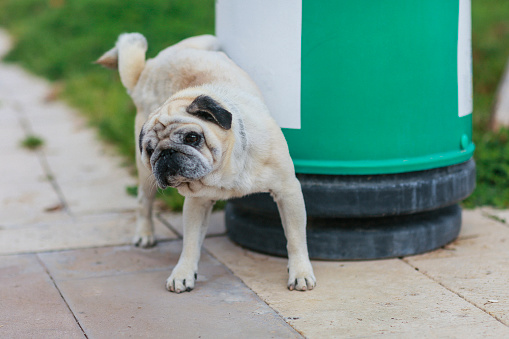Dog owners know the importance of keeping their lawns free of dog poop. Not only is it unsightly but it can also spread harmful diseases and parasites. Fortunately, outdoor dog poop containers can make the task of cleaning up after your furry friend much easier. In this blog post, we'll explore the benefits of using outdoor dog poop containers, how to choose the right one for your needs, the types available in the market features to look for, and the top 5 outdoor dog poop containers for small yards. We'll also discuss how to install and maintain your container and common mistakes to avoid.
Benefits of Using Outdoor Dog Poop Containers
- Easy cleanup: With an outdoor dog poop container, you can easily collect your dog's poop and dispose of it properly without having to search for a suitable location each time.

- Hygiene: Outdoor dog poop containers prevent the spread of harmful bacteria and parasites that can cause illness in humans and other animals.
- Odor control: These containers are designed to keep the odor of dog poop contained, making your yard a more pleasant place to be.
- Environmental protection: By using an outdoor dog poop container you're helping to protect the environment by keeping pet waste out of waterways and preventing pollution.
How to Choose the Right Outdoor Dog Poop Container for Your Needs
Choosing the right outdoor dog poop container depends on several factors such as the size of your yard, the number of dogs you have, and your personal preferences. Some factors to consider:
- Size: The size of the container should be appropriate for the amount of poop your dog produces and the size of your yard.
- Material: Outdoor dog poop containers are available in different materials, including plastic, metal, and concrete. Consider the durability of the material and the weather conditions in your area.
- Design: Look for a design that fits with the aesthetics of your yard and is easy to use
- Cost: Outdoor dog poop containers come in a range of prices. Consider your budget and the features you need before making a purchase.
Types of Outdoor Dog Poop Containers Available in the Market
- In-ground containers: These are installed in the ground and have a lid that can be opened to dispose of the poop.
- Freestanding containers: These are standalone containers that can be moved around your yard.
- Stationary containers: These are fixed to a specific location and cannot be moved.
- Dog waste stations: These are larger units that can accommodate multiple dogs and come with features such as a dispenser for waste bags and a place to dispose of the bags.

Features to Look for in an Outdoor Dog Poop Container
- Durability: The material used to make the container should be durable and sufficient to endure the weather conditions in your locality.
- Odor control: The container should have a lid that seals tightly to prevent odors from escaping.
- Easy to use: The container should be easy to open and close and should not require any special tool or equipment.
- Capacity: The container should have enough capacity to hold the amount of poop produced by your dog.
Top 5 Outdoor Dog Poop Containers for Small Yards
- Doggie Dooley In-Ground Dog Waste Disposal System: This is an in-ground container that uses enzymes to break down the waste.
- Petmate Arm & Hammer Swivel Bin & Rake: This freestanding container comes with a rake for easy cleanup.
- Pooper Scooper with Long Handle: This is a simple and affordable option that allows you to pick up your dog's poop without bending over.
- Earth-Rated Leash Dispenser with Bags: This is a compact and convenient option that attaches to your dog's leash and comes with waste bags.
- Doggy Dare Paw Pail: This is a dog waste station that comes with a dispenser for waste bags and a place to dispose of the bags.
Installing and Maintaining Your Outdoor Dog Poop Container
Once you have chosen an outdoor dog poop container, it's important to install it properly and maintain it regularly. Here are some tips:
- Follow the manufacturer's instructions for installation.
- Place the container in a convenient location that is easy to access and away from areas where people gather or play.
- Clean the container regularly to prevent the buildup of bacteria and odors.
- Use biodegradable waste bags to dispose of your dog's poop.
- Do not dispose of other waste in the container.
Common Mistakes to Avoid When Using Outdoor Dog Poop Containers
- Overfilling the container: Be sure to empty the container regularly to prevent it from overflowing.
- Using non-biodegradable bags: Use biodegradable bags to prevent them from causing harm to the environment.
- Not cleaning the container regularly: A dirty container can attract pests and cause unpleasant odors.
- Placing the container in a high-traffic area: Avoid placing the container in an area where people gather or play to prevent accidental contact with the waste.
Conclusion:
Outdoor dog poop containers are an essential tool for keeping your yard clean and hygienic. By choosing the right container, maintaining it properly, and avoiding common mistakes, you can ensure that your lawn stays spotless and your furry friend stays healthy.
(FAQ)
A: Benefits of using an outdoor dog poop container include keeping your lawn clean, reducing the risk of stepping in dog waste, preventing the spread of harmful bacteria and parasites, and reducing odors.
A: Yes, outdoor dog poop containers come in different sizes to accommodate the waste produced by dogs of different sizes.
A: The frequency of emptying an outdoor dog poop container will depend on the size of the container and the amount of waste produced by your dog. As a general guideline, it is recommended to empty the container once a week.



